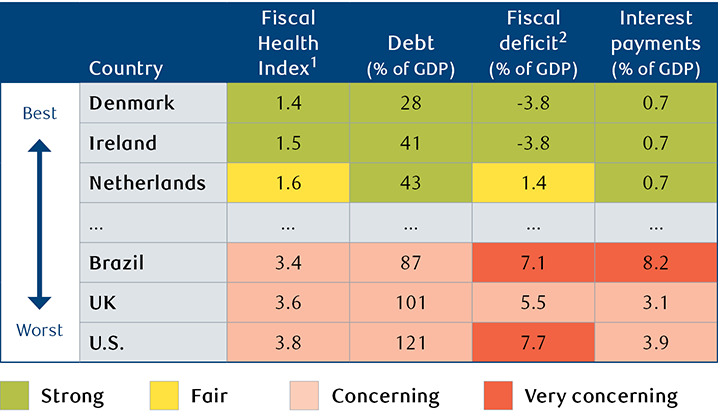Highlights for individual taxpayers
The One Big Beautiful Bill Act (OBBBA) did what was unthinkable when the Tax Cuts and Jobs Act (TCJA) passed during President Donald Trump’s first term back in 2017.
Many of the TCJA provisions which were set to expire at the end of 2025, were not just extended, they were extended indefinitely when the OBBBA passed Congress and was signed into law earlier this month on Independence Day. This affects income tax rates and brackets, the lifetime estate and gift tax, and capital gains and dividend tax rates.
These and other indefinite provisions will be on autopilot for the foreseeable future. They will change only when new congressional legislation passes and is signed into law by the president. This brings more certainty to financial planning.
The OBBBA also introduces temporary measures for the 2025–2028 tax years: A big boost in the tax deduction for seniors aged 65 and older, new tax deductions for tips and overtime pay, and the first auto loan interest payment deduction since the 1980s.
Furthermore, a provision that had haunted foreign individual investors, governments, and companies in allied countries—Section 899, known as the “revenge tax”—was stripped from the bill. After aggressive lobbying by industry and foreign groups, Treasury Secretary Scott Bessent negotiated a compromise with G7 countries.
We think the individual taxpayer OBBBA provisions, along with pro-business measures, helped boost the U.S. stock market as the bill worked its way through the House of Representatives and Senate, and likely have contributed to the market’s good vibes in recent weeks.
One Big Beautiful Bill Act: Select provisions impacting individuals
| Income tax rates and brackets | 2017 TCJA provisions extended indefinitely. But increases the inflation adjustment by an extra year for the three lowest income tax brackets (10%, 12%, and 22%). |
| Standard deduction | 2017 TCJA provision extended indefinitely and with an increase starting in 2025 at $31,500 for joint filers, $23,625 head of household, $15,750 all others. Inflation-adjusted thereafter. |
| Personal exemption | Eliminated; amount set to zero. But higher deduction for age 65 and older (see below). |
| Seniors deduction | Increases extra standard deduction for seniors age 65+ to $6,000 for individuals and $12,000 for joint filers, for itemizers and non-itemizers. Phaseout begins when adjusted gross income exceeds $75,000 for single filers, $150,000 for joint filers. Available 2025–2028, not indefinite. |
| State and local tax (SALT) deduction | Temporarily increases cap on itemized SALT deduction to $40,000 for 2025; increases by further 1% per year through 2029. Subject to phaseout for incomes above $250,000 for single filers and $500,000 for joint filers. In 2030, the maximum deduction drops to $10,000. |
| Alternative minimum tax (AMT) | 2017 TCJA provisions extended indefinitely. But exemption phaseout thresholds revert back to 2018 levels of $500,000 for single filers and $1 million for joint filers (previously $1,252,700); indexed for inflation thereafter. SALT deduction disallowed under AMT calculation. For more on AMT, including impact on municipal bonds, see this RBC article. |
| Lifetime estate and gift tax | 2017 TCJA provision extended indefinitely and increases lifetime exemption to $15 million for single filers and $30 million for joint filers in 2026; inflation-adjusted thereafter. |
| Capital gains and dividends | 2017 TCJA provisions extended indefinitely. Current rates (0%, 15%, or 20%, depending on income) and TCJA modified breakpoints (income ranges where rates kick in) remain. |
| Home mortgage interest deduction | 2017 TCJA provision extended indefinitely; applicable up to $750,000 principal amount. |
| Child tax credit | 2017 TCJA provision extended indefinitely and increased to maximum of $2,200 per child in 2025; inflation-adjusted thereafter. |
| Auto loan interest deduction | New twist on an old (pre-1986) deduction. Interest will be deductible up to $10,000 per year for itemizers and non-itemizers for purchased (not leased) new autos with final assembly in the U.S. Phaseout begins when adjusted gross income exceeds $100,000 for single filers and $200,000 for joint filers. Available 2025–2028, not indefinite. |
| Tips (gratuities) deduction | New deduction of up to $25,000 of tip income within certain industries for itemizers and non-itemizers. Phaseout begins when adjusted gross income exceeds $150,000 for single filers and $300,000 for joint filers. Available 2025–2028, not indefinite. |
| Overtime pay deduction | New deduction of up to $12,500 of overtime pay for individuals and $25,000 for joint filers from federal income tax. Available 2025–2028, not indefinite. |
Note: For the items “extended indefinitely,” there is no sunset provision. These can only change if a new act of Congress is signed into law by the president.
Source - Tax Foundation, Kiplinger, Forbes, Congress.gov, Tax Policy Center, Thomson Reuters, RBC Wealth Management. This information does not constitute tax advice, and the One Big Beautiful Bill Act and IRS tax code are more complex than this summary table.
Highlights for businesses, including companies listed on U.S. stock exchanges
The OBBBA includes pro-business measures that we view favorably. Two stand out:
- Immediate expensing of domestic research and development (R&D) and equipment (short-lived assets) costs was reinstated and extended indefinitely. This reverses the TCJA’s five-year requirement. The nonpartisan Tax Foundation correctly notes that this essentially eliminates a tax penalty for capital investment. The organization assesses that this business provision has “the most bang for the buck,” potentially boosting long-term GDP growth by 0.7 percent.
- Bonus depreciation for improvements made to qualified properties (warehouses, data centers, factories, other facilities, for example) was 60 percent in 2024 and was set to phase down incrementally to zero percent by 2027. The OBBBA reinstates bonus depreciation at 100 percent for properties placed in service after January 19, 2025. This rate is indefinite, so the level won’t change until new legislation passes and is signed by the president. While this will come at a cost for the federal budget, it should free up capital for reinvestment and boost free cash flow and economic growth. The Tax Foundation wrote, “Permanent 100 percent bonus depreciation would reduce federal revenue by $432.4 billion over a decade ($242.7 billion dynamically) but boost long-run GDP by 0.4 percent.”
Among companies listed on U.S. stock exchanges, we think those in the Industrials sector and those tied to the artificial intelligence buildout are the most obvious near- and medium-term beneficiaries of these changes.
Lowlights for green/clean energy
The industry that took the biggest hit in the OBBBA was clean energy.
The RBC Capital Markets Global Commodity Strategy team said the bill will “drastically shift near-term investments and the broad energy landscape.” It reduces clean energy incentives that were included in the Inflation Reduction Act signed by former President Joe Biden, and expands subsidies for oil production, pipeline projects, and coal.
The new legislation speeds up terminations and phaseouts of many renewable energy tax credits, including for wind and solar projects. Because of this, our commodity team anticipates “an acceleration of clean energy projects in the twelve months following bill passage, likely stressing an already full project pipeline and vulnerable supply chains.”
But it seems like this news was priced into many clean energy stocks ahead of time. The NASDAQ Clean Edge Green Energy Index was weak earlier in the year and declined alongside the broader market in the spring, only to rebound sharply since the market’s April 8 low, significantly outpacing the S&P 500.
Problems with deficit projections, and what about tariff revenue?
The cumulative deficit projections associated with the OBBBA vary significantly, whether from the official Congressional Budget Office score, estimates from congressional committees, the Trump administration’s forecast, or estimates from nonpartisan tax organizations.
One of the discrepancies comes from how economic growth is forecast over the budget period, as this impacts the amount of revenue collected. Specifically, there are major disagreements about the economic benefits (or drags) from the OBBBA’s tax provisions and business incentives. This is a decades-old debate in Washington with partisan overtones that we don’t think will be resolved anytime soon.
Estimates for inflation and the cost of debt servicing during the budget period are also swing factors. Another uncertainty is the savings associated with the controversial cuts to Medicaid and the Supplemental Nutrition Assistance Program (once known as food stamps), along with any potential costs that may be incurred from people losing those benefits.
We think it’s best to view the potential deficit impact in terms of a broad range. RBC Global Asset Management Inc.’s Chief Economist Eric Lascelles estimates the OBBBA could cause the cumulative deficit over the next decade to rise between $2.8 trillion and $4 trillion over and above what would have occurred had the legislation not passed. This range includes the more credible estimates in Washington, in our view.
Lascelles notes that tariff revenue could offset a sizeable chunk of this. Therefore, he said the deficit “shouldn’t actually increase by several trillion dollars over the 10-year time horizon.”
Even so, the $37 trillion level is a worrisome starting point. According to Lascelles’ Fiscal Health Index, the U.S. is currently in the worst position among major developed and emerging economies, with a public debt level that is “already fairly burdensome from a debt-servicing perspective.”
Top and bottom three countries in terms of fiscal health

Notes:
1. RBC Global Asset Management Fiscal Health Index (1 = best; 5 = worst).
2. A negative fiscal deficit indicates a surplus.
This is a simplified excerpt from RBC Global Asset Management’s Fiscal Health Scorecard, which analyzes the fiscal health of 27 countries across nine variables. All indicators are based on 2024 data except interest payments (2023).
Source - RBC Wealth Management, RBC Global Asset Management, International Monetary Fund, Macrobond
The table presents fiscal health indicators for the three highest-ranked and the three lowest-ranked countries in the RBC Global Asset Management Fiscal Health Scorecard, ordered from best to worst; 1 is best and 5 is worst. The highest-ranked countries are Denmark (Fiscal Health Index: 1.4), Ireland (1.5), and the Netherlands (1.6). The lowest ranked countries are Brazil (3.4), the United Kingdom (3.6), and the United States (3.8).
In hindsight, for many years investors had the luxury of being able to ignore high federal debt levels, as there were little to no consequences for U.S. financial markets and the dollar. However, due to the significant debt buildup after the global financial crisis in 2008–2009, then even more debt piling on following the pandemic in 2020–2021, and the annual budget deficit averaging a whopping six percent from 2008–2024, the U.S. government’s fiscal outlook should no longer be ignored. For more insight on this topic, see RBC’s recent article, “U.S. debt: Changing facts, updating views.”
Potential economic impact
The $64,000 question about the OBBBA: With positive tax code changes for individuals and businesses, but a greater deficit burden on an already very high federal debt load, what is the likely impact on the economy?
Over the short term, there could be a small drag on growth, according to RBC Global Asset Management. The Treasury Department will need to rebuild its cash reserves, which should temporarily reduce liquidity and act as a mild headwind.
Regarding next year and beyond, Lascelles points out “the main thrust of the budget bill—tax cuts—should permit the U.S. economy to grow somewhat more quickly in 2026, and then be larger than otherwise in subsequent years (though not growing any more quickly). But do not look for an enormous amount of extra growth, as much of the bill represents the extension of expiring policies. This avoids an economic deceleration rather than enabling an acceleration.”

